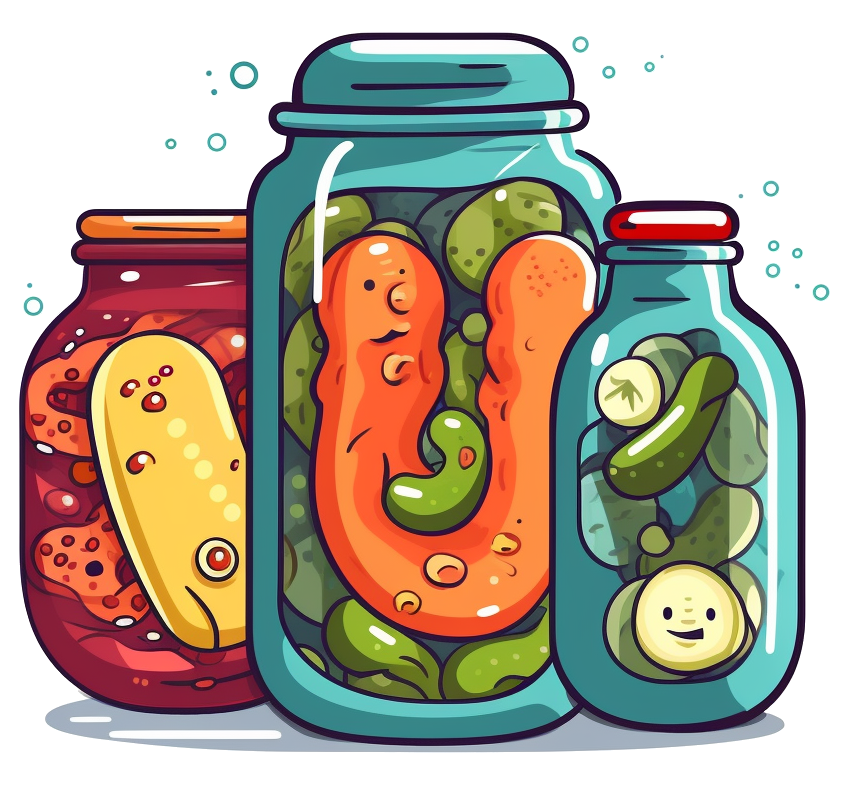I’m thinking mostly of turşu (torshi) and kimchi.
Traditionally, these vegetables are able to ferment fully sealed for weeks, months, or even years. My family ferments turşu for 6 weeks and they fill that bottle to the brim with no problem. But I have seen many reports of people doing European style fermentation who have popped lids and made a mess because they didn’t “burp” the jar.
So what is the difference that makes them not need to release pressure? Can they be made in a metal lid mason jar?
Also, there is vinegar in turşu solution - anywhere from 10% to 50% volume depending on the recipe. Some recipes boil the solution before adding to the jar. I have read many people say both vinegar and boiling will kill your culture, but I have seen both done and they definitely work. Any insights on this?
If you don’t fully seal the jar you don’t need to burp it. You can use any of the following:
- cellophane held on with an elastic
- mason jar lid screwed on so loose that the inner piece can move freely
- an air lock for wine/beer
Vinegar will inhibit many microorganisms, but the ones you care about the most when it comes to wild fermentation (lactobacillus, yeast, and acetobacter) should be ok at low concentrations - keep in mind 2 of these produce their own acid so they have a fairly high acid tolerance - yeast works at a pH of 4-6 though - a 50% vinegar solution is 2.5% acetic acid, which has a pH of ~3 which means it is 10x too acidic for yeast to function
Anything you boil will have all the microorganisms killed off - keep in mind pickling and fermentation are different - recipes that require fermentation will have you cool the vinegar solution before covering the vegetables and that flavor will continue to develop the longer you leave it. Recipes with heavy vinegar content added while still hot to the vegetables are pickle recipes - the flavors will meld over the first couple days but after a week or two, that is when the flavor development will stop - these are the going to be the recipes that don’t explicitly tell you to burp the jar, store uncovered, etc.
Thank you for the informative answer. My family uses glass jars with a rubber seal and a wire lock. Maybe there is some way for pressure to get out, but you can keep the jar fully upside down (actually you are supposed to until it cools to room temperature) and it won’t leak. I’m wondering if there is a vacuum created by the solution cooling in the sealed jar which is enough to offset the gasses. When you open them when they’re finished, they pop open with some force like a carbonated drink.
There is also the chickpeas, which Turkish turşu recipes always include. Chickpeas absorb carbon dioxide, but I have no idea if it’s at a scale that could make a difference. They prevent the juice from getting cloudy too, and I don’t know how they do that either. Any ideas?
As for the solution, that makes sense about the vinegar, but we have definitely boiled the solution, added it to the jar (not while boiling but almost), and had fermentation. I think it might depend on the vegetable structure - perhaps the bacteria in the deep folds of the cabbage survive? I’m not sure, all I can say is it certainly works. These are definitely fermented, not like vinegar pickled veggies (which we also make).
If you can create a waterproof seal odds are it is not capable of venting. The vacuum created by a cooling liquid is going to be trivial compared to the amount of gas being produced by any fermentation process - for context a teaspoon of fermentable sugar in a 250ml mason jar would put the glass at risk of shattering, and at the very least cause it to gush foam when opened. Last time I did fermented chillies for hot sauce I put the lid on too tight and when I loosened the mason jar ring I filled my kitchen with aerosolized scorpion pepper pulp, 0/10 would not recommend. Also note that fermenting in a sealed container is very dangerous - if too much pressure builds, handling the glass can cause it to explode and you could lose a hand
Vegetables will naturally off-gas with age, which may be what is causing the mild amount of pressure build up you are describing? This is decomposition, not fermentation
I haven’t heard anything about chickpeas absorbing carbon dioxide - I know chick pea water is viscous and it may behave similarly to Irish moss/isenglass/agar/gelatin etc in that it acts as a fining agent - it binds to the vegetable proteins in solution and slowly settles to the bottom so all the cloudiness in the solution is concentrated into a thin layer on the bottom instead.
I’m not an expert on vegetable fermentation but I will say if you are adding near boiling water you are definitely killing 100% of the yeast and the majority of the lactobacillus - yeast will die between 40-60C and the more temperature tolerant lactobacillus species between 55-65C - I would look into getting a fermenting lid with a water filled air lock to visualize what is going on. During an active fermentation you should be able to see a near constant stream of bubbles floating up to the surface of the water.
How does one even being to clean aerosolized pepper from a kitchen? That sounds like a nightmare.
It was fine - it was just difficult to breathe and every surface in my house (even after wiping it down) made me cry for a week
deleted by creator
You basically pepper sprayed your house. lol


